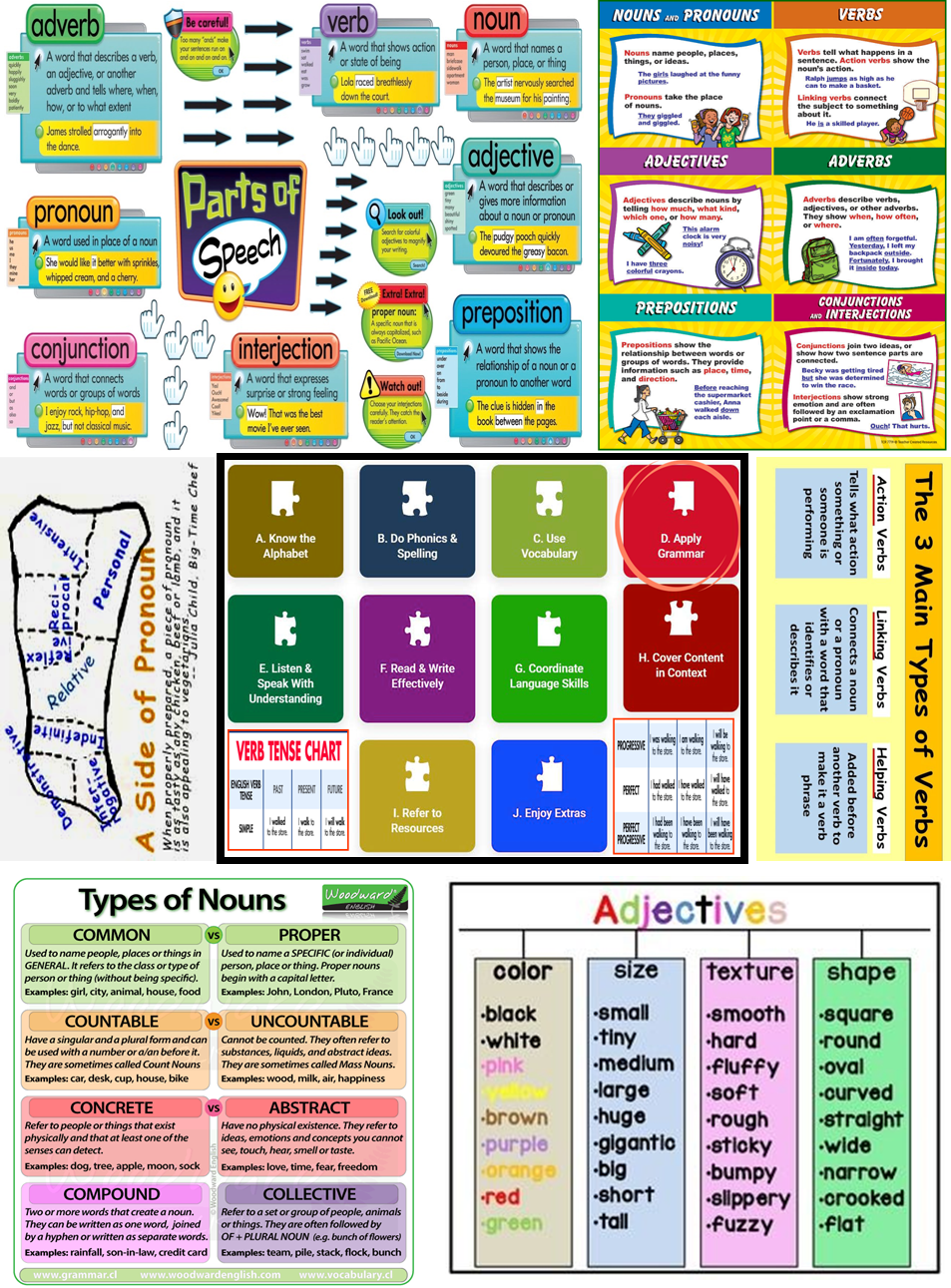Competency Puzzle “Apply Grammar” Pieces D-12.01 to D-12.14: Adverbs & Prepositional Phrases; (Adjective & Pronoun) Possessives; Kinds of Pronouns; Adjective / Adverb Positives, Comparatives, Superlatives, Clauses
Long before lexical items make structured grammar instruction necessary, “Function Words” tend to come up naturally in basic lessons, exercises, activities, and verbal interaction. Without even registering the concept of “Parts of Speech,” learners involve themselves with Prepositions (to, in, of, for, with, . . . ); Articles (a, an, the, . . .); Demonstratives (this, that, these, . . . ); Personal [Subject, Object, Possessive} Pronouns (I, you, us, her, them, mine, his, . . . ); Quantifiers (some, any, enough, . . .); Auxiliaries (can, will, do,. . .); Interjections (Oh, Thanks! Here, Yes, . . .), and other “minor linguistic elements” in utterances they can understand and produce. To illustrate, here are brief excerpts—numbered and described as D-12.01: Part Three of Chapter 3, “Help,” pages 42-44, 47, 52-53 from WorkLife English Workbook 1: Life Skills. They touch on Adverbs, Prepositional Phrases, Personal Pronouns, and a few other basics.
Grammar Rules & Patterns governing function words are likely to slip into coverage of “Major Grammar,” which usually focuses on Nouns, Verbs, Adjectives, and Adverbs. These are the Parts of Speech that predominate. Directives and ideas for teaching / learning them appear in more than one of our previous blog posts, such as How to Put Together the Parts & Pieces That Make Language Work: numbered Apply Grammar Parts & Pieces D-01 through D-11. Even more complete and immediately useful are the many Parts & Pieces to download and whole texts and games available behind Apply Grammar Parts & Pieces D-04, D.07, D.09, D.10, and others at www.worklifeenglish.com.
So what are “Parts of Speech?” In most (onscreen) grammar offerings, eight or nine of these Syntactic Categories of Words are listed:
-
Nouns (words that name People, Places, Things, Ideas)
-
Pronouns (used in place of nouns)
-
Verbs (representing Actions, Activities, Conditions)
-
Adjectives (modifiers of Nouns or Pronouns)
-
Adverbs (modifiers of Verbs, Adjectives, Adverbs, Predicates)
-
Prepositions (short, relational functional words like to, in, with)
-
Conjunctions (connecting words like and, but, so)
-
Interjections (“shout-outs”)
-
Some systems of classification also list Determiners or Articles, words like a /an or the that begin noun phrases.
Straightforward description (characterization) of Parts of Speech is relatively easy to understand. Even so, analyses of Nouns (Indefinite vs. Identified; Singular & Plural vs. Uncountable, Common vs. Proper, Generic vs. Specific, Concrete vs. Abstract, and so on)—and of Verbs (Past, Present, & Future Time Frames; Simple, Continuous, & Perfect Tenses; Modals & Auxiliaries; Infinitives, Gerunds, Participles, & Complements; and even more) can become exhaustingly complex. That’s why they come up in whole series or sequences of Lessons, Chapters, Units, Texts, and downloadable segments of material.
Surrounding the usual “What to Do in a Complete Course of English-Language Study Puzzle-Pieces A-J Chart” (with “D. Apply Grammar” circled) Chart, here’s a sampling of the kinds of Graphic Organizers + other Visuals that appear in searches for these topics.
This article is the eighth installment of “How to Put Together Puzzle Parts & Pieces That Make Language Work: “Apply Grammar.” Its collective fields of focus are major Parts of Speech (other than Nouns & Verbs) that warrant attention in grammar instruction—mainly Pronouns, Adjectives & (one-word) Adverbs.
Following is commentary on a few of these pieces of material. Within this verbiage are sample segments to download and use for (self-)instruction straight away, including a number of (complete) Parts & Pieces.
D-12.03 to D-12.06 = Kinds & Uses of Pronouns
Nearly all (inserted) “Lessons” on Pronouns present and practice the forms of Subject & Object Personal Pronouns such as I / me, we / us, you / you. they / them, etc. Most beginners learn these with Possessive Adjectives (my, our, your, his, etc.)—and (later) related Possessive Pronouns (mine, ours, hers, theirs, etc.). Then at various stages of language-acquisition, they begin noticing and using other kinds of Pronouns: Reflexive, Reciprocal, Generic Impersonal, Indefinite.
Here’s an extensive intermediate-level excerpt labeled D-12.06: Unit 11: Pronouns (“Mirrors” or “The Peddler”) of the New Scenario Two: Continuing to Use English Grammar in Context. In a folk story about people whose relationships and lives change adversely as soon as they see themselves in Mirrors, readers / listeners begin by identifying kinds of Pronouns (and the Nouns they refer to). Suddenly, the storyteller needs not only Personal but also Indefinite & Reflexive Pronouns—like everybody, anything, (some)one; themselves, himself, ourselves, . . . ) to further the narrative.
After Comprehension Sections come Grammar Notes on and Practice in Kinds of Pronouns; Personal Pronouns ( I / me / mine, we / us / ours, etc.); Generic Impersonal Pronouns (one, we, you, but don’t mix them!); Singular & Plural 1st, 2nd, & 3rd Persons Reflexive Pronouns (myself, ourselves; yourself, yourselves; himself, herself, itself, oneself, themselves); Other Uses of Reflexives (for emphasis, to mean “also,” “the natural self,” or “without help”); Reciprocal Pronouns (each other, one another); the Indefinite Pronoun One(s) & other Indefinites (somebody[’s], everyone[’s], anything, none), and Summary of Pronouns.
Unique in this extensive coverage is a visual game empowering players to identify items with precise use of the Pronoun One(s). Also, the Chapter ends with Photo Montages & Composition Topics that lend themselves to application of various Kinds of Pronouns: 1. “Being in Love,” 2. “Selfishness & Vanity,” 3. “Dependency vs. Self-Sufficiency,” 4. “Solitude / Isolation.”
To get either or both of the two segments on Pronouns described above, here are visuals you might also click on.
D-12.08 to D-12.14 = Positive, Comparative, Superlative, & Other (Degrees of) Adjectives / One-Word Adverbs, & Adjective Clauses
Usually in basic English instruction, Adjectives (Describing Words to Modify Nouns & Pronouns) are first presented and practiced in the phrase pattern Adjective + Noun. (Here’s an shortened sample to click on and download: D-12.01: Part Two of Chapter 1, “Things,” pages 14-16, from WorkLife English Workbook 1: Life Skills. And as soon as whole sentences are introduced, learners are likely to read, hear, and use Adjectives after Linking Verbs, especially be.
But of course, the study of any Part of Speech can’t be as simple as that. When language teachers / students at advancing learning levels analyze Adjectives, they’re likely to notice their sentence positions: before nouns; after linking verbs; as “object complements” with verbs like like, find, or consider; after indefinite pronouns such as someone or anything; and in established sequence (size/shape + quality + nationality + noun-adjective), in long noun phrases. One-word Adverbs can appear in several wording slots. Regarding word forms, Adjectives may be derived from Nouns or Verbs; Adverbs of Manner often end in –ly.
These “Grammar Learning Points” appear in Part One: Adjectives & Adverbs of D-12.09: Chapter 7, “Getting Along with People,” of WorkLife English Grammar 5: Language & Culture in Depth. This instructional Download then continues with Part Two: Comparison; Part Three: Superlative Forms; and Part Four: Summary of Adjectives & Adverbs.
What are some features of D-12.09 that not only engage but also work pedagogically? There are amusing, content-rich anecdotes to correct grammatically—titled “The Wedding,” “Social Customs & ‘Rules’ of Respect,” and “The Guest Who Came to Visit for ‘A Few Days’.” There are “interesting” phrasing patterns like as Adjective / Adverb as; (omission of) than after Comparatives; the emphasis of Comparative and Comparative phrasing; repetition in the pattern the Comparative, the Comparative; and expressions exaggerating Superlatives like “of all,” “in the (whole) world,” “the most / least Adjective / Adverb possible, “ever,” or “of all time.” So while managing the progress of your / others’ linguistic fluency, you can enjoy the material of this 18-page download.
So what else is there to learn about in regard to Adjectives & Adverbs and their ramifications as offered above? Well, in D-12.10: Chapter 4, “Business & Work,” from WorkLife English Grammar 6: Issues & Answers, there’s the recycled grammar and renewed content of 10 distinct one- or two-page offerings: Lesson 31: Adjectives in Noun Phrases; 32: Adjectives After Linking Verbs; 33: Object Complements; 34: Adjectives & Adverbs: as . . . as; 35: Comparative Forms; 36: Double Comparatives: the . . . the; 37: Superlatives; 38: Adjective Clauses: Pronouns; 39: Adjective Clauses: Subjects vs. Objects or Adverbs: and 40: Adjectives After Nouns & Pronouns. So in addition to reviewing Adjective / Adverb structures in Simple Sentences, you (and your learners) are invited to begin understanding and using them in Dependent Clauses.
Beyond Simple Sentences, the “Advanced Grammar” of Complex-Sentence Combining: Independent & Dependent (Noun, Adjective, & Adverb) Clauses has been postponed to over and above currently relevant instructional grammar concerns. All of those upcoming blog posts and Parts & Pieces are being reserved for when educational life “returns to normal.”
Even so, just to make our offerings “come out even,” here’s D-12.12: Unit 7: Adjectives: Words, Phrases, Clauses (“Witness”)—from the Original Scenario Volume 2: English Grammar in Context. Its 12 vintage pages (re-)present, practice, and assess mastery of Adjectives in Noun Phrases; Adjectives After Linking Verbs; Adjectives After Nouns & Pronouns; Object Complements; Adjective Clause (Subject Pronouns, Object Pronouns, Pronouns for Adverbs & Possessives, Essential & Non-Essential Adjective Clauses, & Summary. Feel free to use and re-use them for all they’re worth.
To click on if you feel like it, here are initial pages of the four segments on Adjectives & Adverbs described above. As always, you can get more Grammar, in this case of Describing Words, behind Puzzle Piece D: Apply Grammar at worklifeenglish.com.
And also as accustomed, here are direct links to some complete Competency–Based Grammar Texts and both original and revised “Grammar-in-Context” Series referenced in this article:
For monthly email newsletters with free tips, tools, and resources for English language teachers and learners, sign up here!













